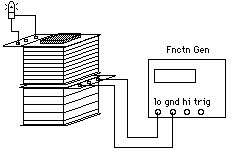Difference between revisions of "Transformers--Frequency Dependent"
From UO Physics Demonstration Catalog
| Line 1: | Line 1: | ||
{{NewDemo|subject=Electricity and Magnetism|topic=Inductance|file1=Transformers - Freq Depend.gif}} | {{NewDemo|subject=Electricity and Magnetism|topic=Inductance|file1=Transformers - Freq Depend.gif}} | ||
A step up transformer is | A demo that shows a transformer requires an alternating current to work. A step up transformer is set-up as shown. With the function generator putting out a 60 Hz sine wave to simulate commercial power, the light bulb lights up easily. As the frequency is reduced the brightness of the bulb also decreases until is eventually goes out altogether. A two channel oscilloscope can also be used to track the relationship between the input and output wave forms. | ||
'''Location:''' | '''Location:''' | ||
* Transformer Coils: Shelf J-3 | |||
* Signal generator: Shelf | |||
* Oscilloscope: Black Cabinet | |||
* | * | ||
Latest revision as of 13:38, 18 January 2023
Return to Inductance
Description:
A demo that shows a transformer requires an alternating current to work. A step up transformer is set-up as shown. With the function generator putting out a 60 Hz sine wave to simulate commercial power, the light bulb lights up easily. As the frequency is reduced the brightness of the bulb also decreases until is eventually goes out altogether. A two channel oscilloscope can also be used to track the relationship between the input and output wave forms.
Location:
- Transformer Coils: Shelf J-3
- Signal generator: Shelf
- Oscilloscope: Black Cabinet
